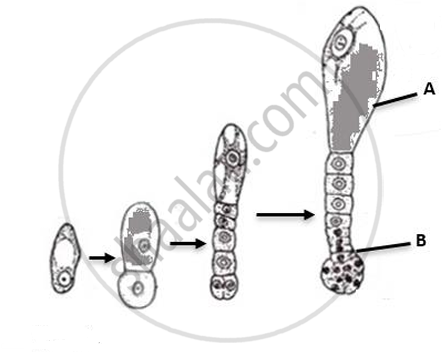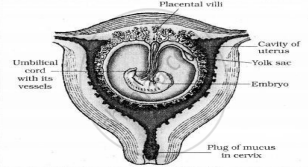Advertisements
Advertisements
Question
During embryogenesis in dicots, the zygote divides into a basal cell and a terminal cell. The basal cell divides repeatedly to produce a structure called suspensor. Carefully observe the image given below and describe the function of cell – A and cell – B of the suspensor.

Zygote
Solution
Cell – A: The haustorial cell absorbs and transfer nutrients from the endosperm to the proembryo.
Cell – B: Hypophysis forms radicle.
APPEARS IN
RELATED QUESTIONS
Comment on the role of placenta as an endocrine gland.
Mention any two functions of the human placenta.
Which of the following hormones is not secreted by human placenta?
The first movements of the foetus and appearance of hair on its head are usually observed during which month of pregnancy?
The early stage human embryo distinctly possesses ______.
The concentration of which of the following substances will decrease in the maternal blood as it flows from embryo to placenta through the umbilical cord?

The human foetus within the uterus
- Oxygen
- Amino Acids
- Carbon dioxide
- Urea
Which of the following is not a function of the placenta?
Read the following and answer from given below:
Cleavage is the series of rapid mitotic divisions in the zygote and forms blastula. The 2, 4, 8, 16 daughter cells are called blastomeres. An embryo with 64 blastomeres is known as a blastocyst and has a blastocoel cavity. Blastocyst gets implanted in the uterine wall and leads to preganancy.
The solid mass of cells with 16 blastomeres is called ______
Read the following and answer from given below:
Cleavage is the series of rapid mitotic divisions in the zygote and forms blastula. The 2, 4, 8, 16 daughter cells are called blastomeres. An embryo with 64 blastomeres is known as a blastocyst and has a blastocoel cavity. Blastocyst gets implanted in the uterine wall and leads to pregnancy.
The correct sequence of various structures formed during embryonic development is ______
The diagram given below represents a specific stage of human embryonic development. Identify the stage.

